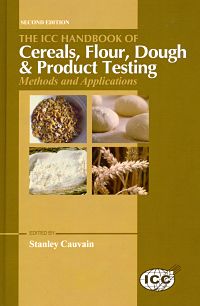Somewhere Over The Grain-Bow
By Jennifer Zegler
With manufacturers searching for successful whole grain and higher-fiber products, ingredient companies are developing innovative components to help in the journey down the “yellow brick road.”
Ding-dong, low carb is dead! Following the death of the “Wicked Witch” known as low carb, companies found themselves in a strange land searching for the next trend. Amid the songs and dances of the Munchers — consumers with a penchant for snacks— ingredient producers started heading toward the Trendy City, hot on the trail of the next big thing. Before they knew it, they found the answer.
“It could be a ‘perfect storm’ type situation, where a couple of things have happened,” says Marcia Scheideman, registered dietician and president of the Wheat Foods Council, Parker, Colo. “We’ve had more and more nutrition research showing the real strong health benefits of whole grains on chronic diseases and the war against obesity. Then the 2005 Dietary Guidelines [for Americans] were released in support and quantifying the amount of whole grains necessary. I don’t know if they all happened because of each other or at the same time.”
It seems the low-carb fad may have not been as ‘wicked’ as perceived since it did create some good.
“As much as we decried [the low-carb trend], it did emphasize that if you’re ever going to eat a dreaded carb, make it a good carb,” says Cynthia Harriman, director of food and nutrition strategies for the Whole Grains Council, Boston. “At least this time we kept the baby and threw out the bath water because the only good thing to come out of low carb was the understanding of good versus bad carbs.”
Ingredient companies realized that American consumers’ wishes were going to change to “There’s nothing like whole, there’s nothing like whole … grains.” Although demand is growing, Americans are as confused as a scarecrow without a brain about what whole grains are and their benefits.
“We have found that even nutrition professionals cannot identify what is a whole grain,” explains Judi Adams, president of the Grain Foods Foundation, Ridgway, Colo. “If they can’t, you know the consumer is having problems. How are they going to consume three whole grains a day if they don’t know what a whole grain is? Having [the gram content] on the label, in an accurate and not misleading statement, will help everyone reach the recommendations.”
The FDA tried to play Glenda the Good Witch by giving guidance for labeling whole grains, but the final word won’t be released until later this year. This month, the Whole Grains Council released revised stamps with the number of grams per serving of whole grains as recommended by the agency. Ingredient companies are laying the yellow brick road to aid manufacturers and bakeries in their search for the Trendy City, where great taste and healthful benefits live in harmony.
If It Only Had Bran …
Whole grains and fiber in their pure form are not yet ready to be accepted by the masses, so ingredient companies have created transition ingredients to help them along the way. This has paved the way for transition foods such as whole grain white bread. Similar to the Wizard’s smoke-and-mirrors tricks, these products have the nutritional benefits of whole grains, but the taste and texture of white bread.
“There are a lot more whole grain products out there and a lot more innovative products like white wheat … and others with new ways of approaching the whole grain issue,” says Lee Sanders, senior vice president of government relations and public affairs for the American Bakers Association, Washington D.C.
Archer Daniels Midland Co. (ADM), Decatur, Ill., started working on whole grains before the trend hit, explains Dr. Stan Andrews, Ph.D., manager of bakery ingredient applications for the company.
“We started working on whole grains for bakery companies in the middle of low carb two years ago, and the crash of low carb has led a rise of whole grain and fiber,” he says. “I’ve been working on it for awhile, but ADM has been looking ahead a little bit.”
The company launched Kansas Diamond, a new white whole wheat flour, in April. This finely granulated flour has a slightly sweet flavor and is a great source of fiber and protein. Kansas Diamond is milled from ADM’s specially selected blend of hard white wheats and can be used in pizza, tortillas, breads, buns, bagels and cookies.
Meanwhile, Omaha, Nebraska-based ConAgra Mills’ Ultragrain white whole wheat flour has been appearing in more and more products since its launch in the fall of 2004. The ingredient is made with the company’s proprietary variety of Platte wheat for a milder taste, lighter color and smoother texture that’s more akin to refined white flours. However, Ultragrain retains the fiber, phytonutrients and other nutritional benefits of 100% whole wheat flour through patent-pending milling technology.
Another manufacturer, Horizon Milling, a Minneapolis-based joint venture between CHS Inc. and Cargill Food Ingredients, has unveiled two new ingredients ready for transition foods, which combine whole grain benefits with the taste and texture of traditional products: WheatSelect white spring whole wheat flour and GrainWise Wheat Aleurone. WheatSelect uses a white spring wheat, in contrast to the more common red spring wheat, to provide 100 percent whole wheat nutrition. Yet, the product has the lighter color, softer texture and milder taste that consumers prefer. It also helps optimize key baking characteristics such as volume, mixing and processing tolerance.
“WheatSelect uses a white spring wheat variety specifically bred for lighter color, better taste and premium baking performance,” says Sheryl Stennett, vice president of marketing for Horizon Milling. “Our supply chain and identity preservation systems allows us to manage and control the quality from beginning to end.”
GrainWise Wheat Aleurone provides a nutritional profile similar to traditional whole wheat flours with the sensory qualities of white flour. The Cargill product replaces a portion of the white flour in a product’s formula without adding the pigment or strong flavor of whole wheat, thus allowing baked goods to retain the kid-friendly texture and color of white bread. GrainWise also contains 45% dietary fiber and, when added in sufficient quantities, can boost the fiber content to “good” or “excellent” source levels.
“Basically, taste, appearance and texture are improved compared to whole wheat,” explains Bill Atwell, technical leader of the bakery technology group at Cargill. “Blending GrainWise with white flour will actually create a whiter and less coarse blend. The bitter flavor that can be associated with whole wheat is also not there, which kids don’t tend to like. It’s a unique formula for achieving all the nutrition of 100% whole wheat, but without any of the bitterness of bran.”
Last year, Cargill Food Ingredients introduced MaizeWise, a new line of whole grain corn products that are applicable in snacks, breads and batters. MaizeWise whole grain corn products can be used as a direct replacement for corn meal, masa or corn flours or can be blended with other ingredients. “They deliver 100% of whole grain nutrition, are specially treated for enhanced storage stability and come in a spectrum of flavors,” explains Jennifer Shomenta, commercial manager of dry corn ingredients for Cargill Food Ingredients.
If It Only Had Fiber …
Although all whole grains contain fiber, many products do not contain enough of them to be labeled a “good source of fiber.” Just as the Wicked Witch of the West sought after the ruby red slippers, companies are seeking ways to incorporate more fiber into both whole grain and non-whole grain products. Ingredient companies are helping manufacturers to do this.
For example, ADM’s FiberSol 2 is a soluble dietary fiber that does not affect the taste of food. The digestion-resistant maltodextrin disperses rapidly and is highly soluble and stable under virtually all conditions, including in baked goods and snacks. FiberSol 2, which provides fiber throughout digestion, also can mask bitter notes in taste.
“The addition of FiberSol 2 to a product doesn’t just add fiber, but taste,” Andrews explains. “It’s 100% soluble in hot or cold water. It has no effect on the pH of the product. A lot of natural root-type fibers will break down in acidic environments, but FiberSol 2 is a corn-based product. It’s also easy to work with.”
ConAgra Mills has continued the company’s innovation with Sustagrain barley, which is the first commercially available whole grain product that is high in dietary fiber and low in starch. Sustagrain has one of the lowest glycemic index levels commercially available and is offered in flour, kernels, flaked, steel-cut and quick-cooking rolling forms. The concentrated product can be added in small doses not only to boost the fiber, but also to enhance the flavor, texture, appearance and nutritional composition in a variety of applications.
“At 30-gms of total dietary fiber per 100-gms, Sustagrain barley is very fiber dense, so adding even a small amount to snacks and baked goods gives applications from energy bars to smoothies a big nutritional benefit,” says Mike Veal, marketing director for ConAgra Mills.
A variety of fiber-boosting ingredients is available from Cargill Food Ingredients. They include Oliggo-Fiber inulin, derived from chicory roots; ActiStar resistant starches, made from tapioca; and MaizeWise corn-bran products.
The Oliggo-Fiber inulin is a natural soluble fiber that can increase fiber content levels without affecting taste and texture. ActiStar is available in two forms: resistant maltodextrin and resistant tapioca starch. The resistant maltodextrin can be used in moist cookies, brownies and muffins, while the resistant tapioca starch is for lower net carbohydrate baked goods. MaizeWise corn bran is an insoluble fiber than can dramatically boost dietary fiber at low to moderate inclusion rates, while providing minimal impact to flavor, texture and processing characteristics for a wide variety of food products.
Made from pure citrus fiber, Citri-Fi from Fiberstar of Willmar, Minn., not only provides fiber, but also is a functional ingredient. Citri-Fi contains a significant amount of insoluble fibers without imparting a gummy mouthfeel or masking flavor.
“The three key areas in which Citri-Fi is used include a moisture management tool, strengthener and fat replacement,” says Brock Lundberg, vice president of technology for Fiberstar. “For baked goods and fat replacement applications, the most popular products are the Citri-Fi 100 citrus fiber and Citri-Fi 100FG citrus fiber fine grind product.”
Also making their way into the fiber frontier are prebiotic ingredients. For example, Litesse from Denmark-based Danisco is a low-calorie, sugar-free, low-glycemic ingredient that also is high in fiber. One of the benefits of its high fiber content is that it increases the feeling of fullness or satiety. Litesse can be added to snacks, nutrition bars and baked goods to help consumers consume of fewer calories.
Although American consumers are realizing that “there’s nothing like whole … grains,” fully whole grain products have yet to fly off the shelves. Transition products such as white wheat bread are just the first stops on the way to see the Wizard of Consumer Happiness. Since manufacturers have found themselves “over the grain-bow,” ingredient companies have been helping them to see that better-for-you products are the new trend. SF&WB







